BioFabricating Materials¶
 This week focuses on exploring material alternatives to the current ones. By bridging craftsmanship techniques and todays easier access to technologies, we explore alternative material resources in order to craft their processing and develop products and materials hand in hand.
The assignements are:
This week focuses on exploring material alternatives to the current ones. By bridging craftsmanship techniques and todays easier access to technologies, we explore alternative material resources in order to craft their processing and develop products and materials hand in hand.
The assignements are:
- Include some inspiration: research on artists, projects, platforms that work with biomaterials, local ingedients and resources
- Produce at least two grown and/or two crafted materials: Grown materials - Grow a material, experimenting with at least 2 different recipes and variations thereof. Document the process, ingredients, changes, describe and compare the materials Craft materials - Craft a material, experimenting with at least 2 different recipes and variations thereof. Document the process, ingredients, changes, describe and compare the materials
- Document your recipes, the ingredients and process and if there have been changes, document your unexpected discoveries
- Name your materials, classify them by typology and display them in a systematic order of samples.
- EXTRA POINT: Submit some of your swatches to the analog material library of your lab. (20cm *20cm aprox)
3 european brands revisit the concept of fruits waste¶
KUORI : from banana peels to 3D printing (Switzerland)¶
Bananas are one of the most popular fruits in Switzerland and are offered to the consumer exclusively through imports throughout the year. This has an enormous ecological and economic impact. KUORI describes the research work of new materials from banana peels and their applications in the sense of the Circular Economy. The concept deals with further processing of the peels, thus expanding the cycle of the banana fruit and significantly reducing the amount of its waste.

The areas of application are very diverse. Depending on the processing and use of different components, KUORI can be applied both as a material in the textile sector, as a sustainable single use object, in the packaging sector or 3D printing. Within the Bachelor Praxis at the Institute of Industrial Design, Basel four different products were created from the banana peel. One off the successful experiment was the production of 3D filament and ultimately a 3D printed cylinder. Due to the fiber composite of the banana peel in the material, the resulting object has a higher stability compared to ordinary PLA.
PEELSPHERE® : from fruit waste to multiple materials (Germany)¶
PEELSPHERE® is a material innovation company founded by a team of designers, engineers, and entrepreneurs.

After gathered, the fruit wastes are mixed and ground into fine pieces, they are further blended with bio-binder into a mixture with natural or Oeko-Tex certified dyes. The mixture then forms sheets of materials and is dryed. It can be laser-cut, embroidered, woven, and sewn into end products that are biodegradable and timeless.
AppleSkin™ : from apple waste and PU to leather (Italy)¶
Mabel is a leading manufacturer of coagulated and coated fabrics in synthetic leather. Since 2010 the Company has been producing AppleSkin™.

In South Tyrol, in Italy, the apples destined for the food industry generate wastes (cores and peels), they are thermally destroyed or deposited in landfills. Waste from the food chain is recovered by Bolzano-based company Frumat, to get a powder. This powder is used by Mabel to substitute oil derivatives which mixed it with organic cotton and recycled PU. At the end of the process they obtain a vegan, durable, waterproof material (composition: 32% apple waste, 34% organic cotton, 34% recycled PU) and carbon emissions of 7.6kgC02/m2 versus 60.1kgC02/m2 for animal leather. They provide european craft and textile industries in all Europe for shoes, bags, furnitures...
Banana (almost) rubber¶
Objectives¶
Inspired by KUORI research, I wanted to give a try to banana peels by working with the almidon and of the peal and without adding alginate as view in other fabricademy proposals. I try a mix to make a reaction with vinegar (acetic acid) as indicated in the recipe book of the Textile Lab for tapioca.
Process to get the paste¶
* Banana peels without extremities 245 g
* Water 250 mL
* Vinegar 200 mL
* Glycerine 20 g
* knife
* cutting board
* saucepan
* heat source
* blender
* cheesecloth
* strainer
* measure all ingredients
* smach into small pieces the peels
* cook together peels, water and half the vinegar for 2h
* when all the liquid is evaporated add the remaining vinegar
* let cool
* mix finely
* add the glycerine
* press the preparation to wring it out as much as possible
Using the paste¶
The obtained paste is very maleable. If it could be suitable for 3D printing, I have some doubts about the drying process.
I tried to shape it like clay but the results were not very clean. My choice was to press mold it between two glass jars. I also make 3 samples with differents thickness.
After drying in a desiccator at 35º for 10 hours to avoid the development of mold, and 70h outside, here is the result (diameter : 6cm).
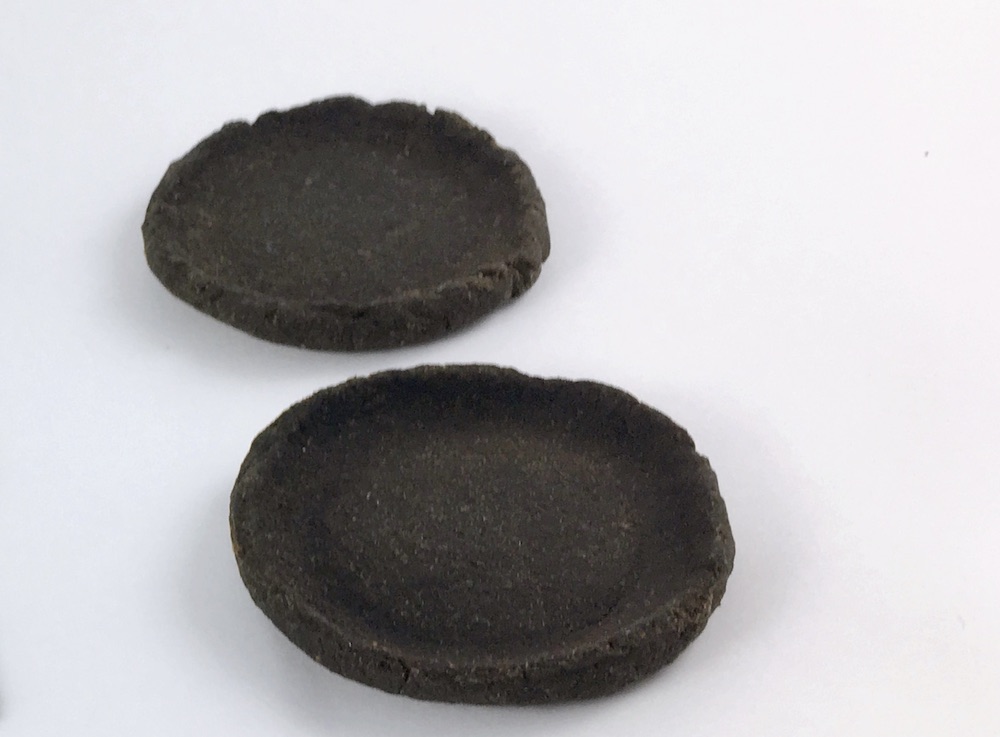
Samples size and thickness reduction¶
| Original size | Original thickness | Picture | Final size | Size reduction | Final thickness | Thickness reduction |
|---|---|---|---|---|---|---|
| 35 x 31 mm | 2 to 3 mm |  |
29 x 26 mm | 16% | 1.5 to 2 mm | 30% |
| 35 x 31 mm | 4 to 5 mm |  |
30 x 27 mm | 13% | 2.5 to 3 mm | 38% |
| 35 x 31 mm | 7 to 8 mm |  |
30 x 28 mm | 10% | 4 to 4.5 mm | 43% |
Resistance¶
The material obtained is relatively flexible but still gets a breaking point. I don't have the necessary tools and material quantities for strength measurements.
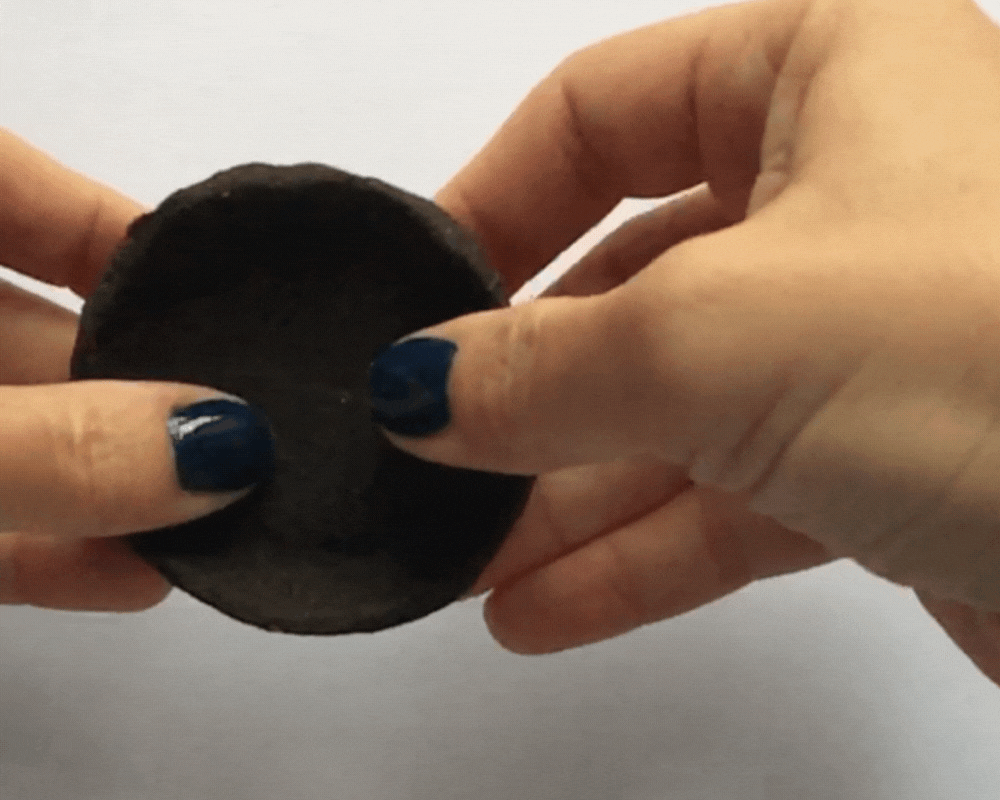 Unfortunately, the pseudo banana rubber has no resistance to water, it disintegrates as soon as it is soaked in water even without rubbing.
Unfortunately, the pseudo banana rubber has no resistance to water, it disintegrates as soon as it is soaked in water even without rubbing.
Possible uses¶
I definitly than the best way to use the banana paste is by pressure casting, for some flat of almost flat items. Even if I think than a drying time should always be necessary, I would like to give a try during week 10 to 3D print the paste. To be continued...
Alginate colored threads¶
Origins¶
Alginate¶
Alginate is produced from seaweed that is soaked in mineral acid and then ground in an alkaline bath. One of the problems of alginate production is the arsenic waste extracted from the seaweeds. Alginates are used as thickeners, gelling agents, emulsifiers and stabilizers in a wide range of industrial products from food jellies and cosmetics to paints and printing inks.
Calcium chloride¶
To obtain an alginate bioplastic, you need: alginate (obviously) and calcium chloride. Calcium chloride is obtained as a subproduct of the chimical fabrication of sodium carbonate wich is used industrially in glassmaking, soapmaking, steelmaking... The Solvay process is the chemical process for the synthesis of sodium carbonate from salt and calcium carbonate. The process uses ammonia which is not consumed but reused after regeneration and recycling. All this process is a very industrialised chemitry.

The calcium chloride is used in agribusiness and on other industry to capture moisture it's a discontinued weedkiller. The manipulation of calcium chloride have to be with glove and protection glasses.
Recipes¶
I used the basic recipe from the Textile Lab with more oil for the pigmented threads and dye bath for instead of the water for the natural dye ones.
Alginate with pigment¶
* Water 300 mL
* Alginate 9 g
* Glycerine 15 g
* Yellow pigment 5 g
* Sunflower oil 10 g
* Water 1500 mL
* Calcium chloride 150 g
* beaker
* basin
* mixer
* spatula
* syringe
* measure all ingredients
* mix sunflower oil to pigment
* make an emulsion with the 400mL water, alginate and oil
* let rest for 2 hours to let the bubbles escape
* prepare a 10% calcium chloride solution
* extract alginate threads with a syringe in the calcium chloride solution
* let the threads 5min in the solution
* rince in water
* put the threads to dry by stretching them
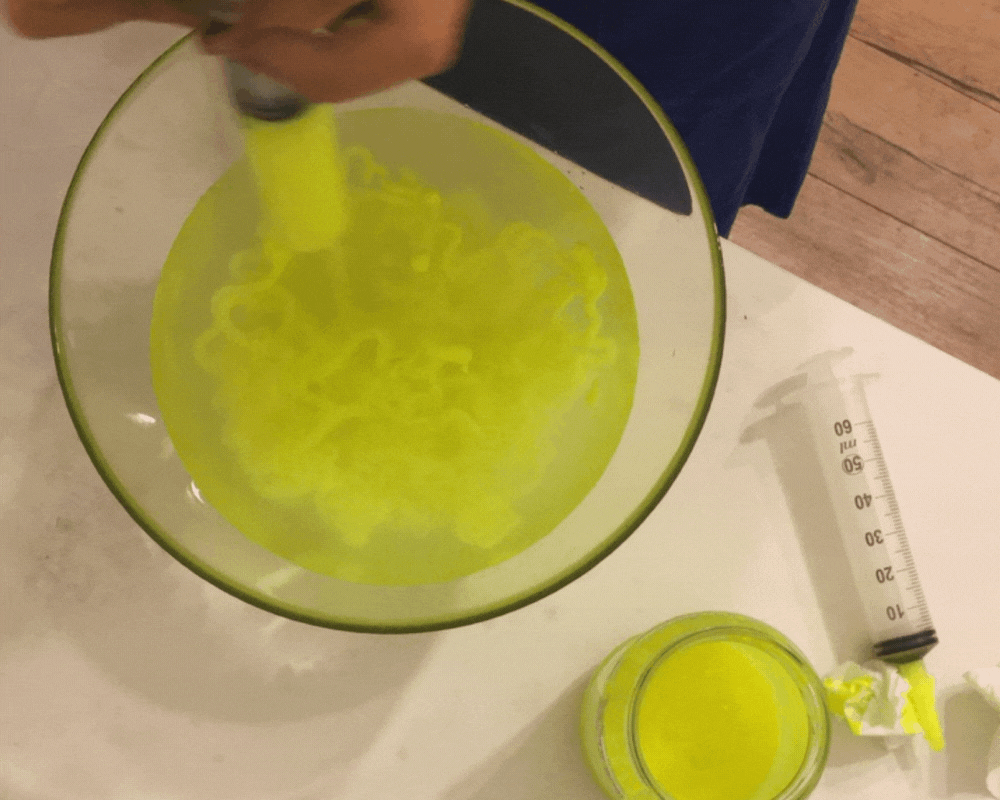
Alginate with natural dye¶
* Logwood dye bath 500 mL
* Alginate 15 g
* Glycerine 25 g
* Sunflower oil 12 g
* Water 1500 mL
* Calcium chloride 150 g
* beaker
* basin
* mixer
* spatula
* syringe
* measure all ingredients
* make an emulsion with the 400mL dye bath, alginate and oil
* let rest for 2 hours to let the bubbles escape
* prepare a 10% calcium chloride solution
* extract alginate threads with a syringe in the calcium chloride solution
* let the threads 5min in the solution
* rince in water
* put the threads to dry by stretching them
Regularity or irregularity¶
The regularity of the threads will depend on the regularity of extraction and the available space in the calcium chloride solution so do not hesitate to wait between each syringe to remove the threads already made in order to free up space. Personally, I really like the outgrowths that the threads makes by winding on itself during the reaction.
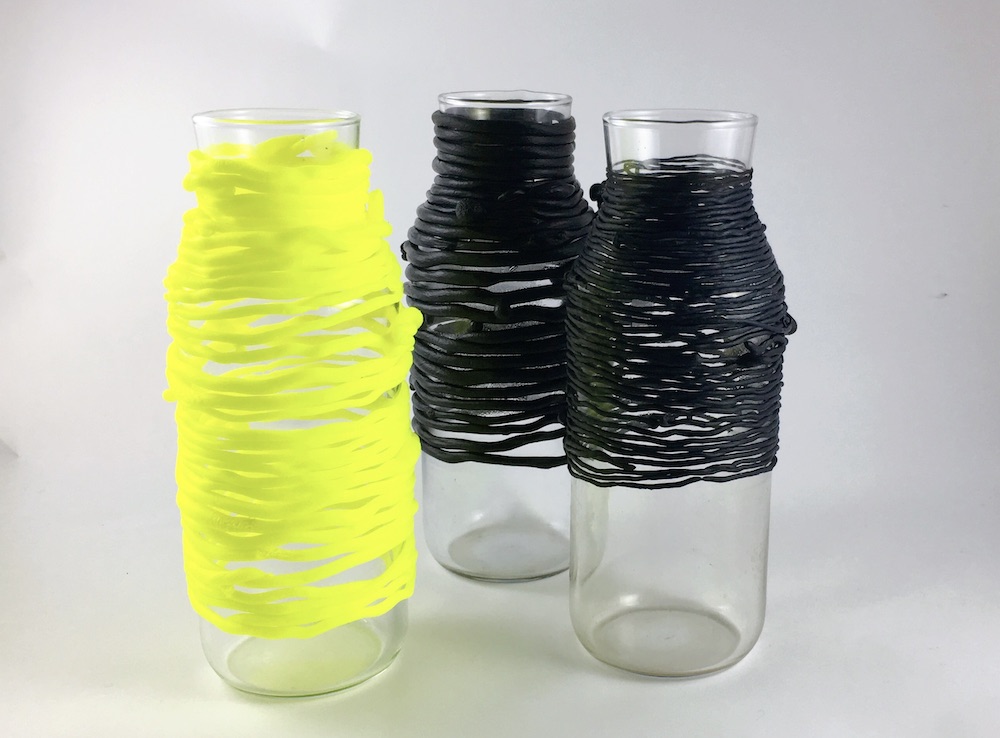
Weaving the alginate threath¶
The alginate threads lose their flexibility as they dry. You have to work them while they are dry enough so that part of the loss of volume has already taken place. I think it would be possible to use them in basketry with another material for the main stems. I chose to weave the threads with nylon as warp threads 48h after making them. Here is the result 72h after they were made.
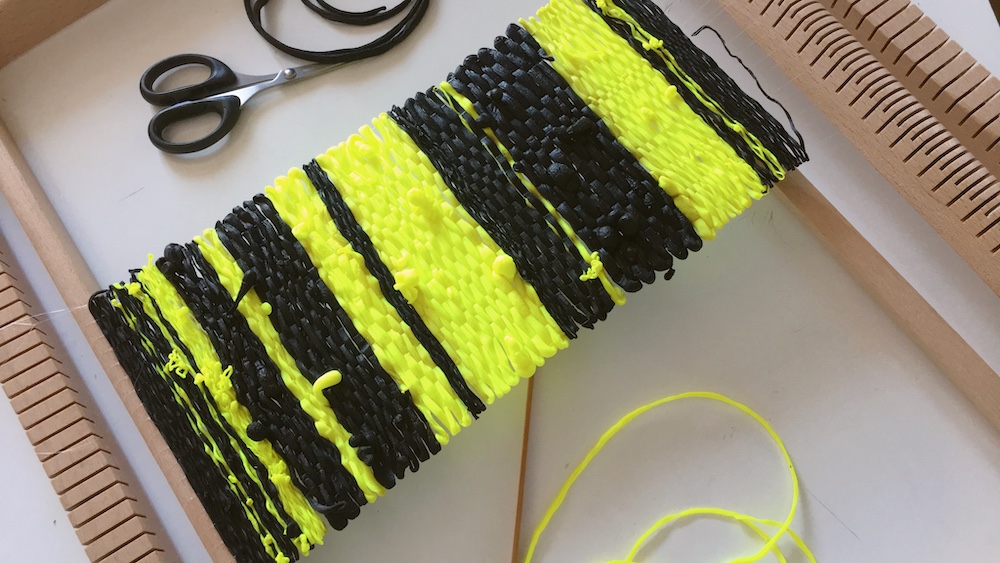 Weaving threads with outgrowths is tricky but I wanted to keep them, I cheated on the regular threads that were easy to weave by adding outgrowths because I prefer the irregular effect. So if I do it again I would plan threads as regular as possibles and some small beads to add after :P
Weaving threads with outgrowths is tricky but I wanted to keep them, I cheated on the regular threads that were easy to weave by adding outgrowths because I prefer the irregular effect. So if I do it again I would plan threads as regular as possibles and some small beads to add after :P
Saving energy with mycellium¶
This project was done during week 9 with Amandine Fery, if you got interest in mycelliums please check her week09 page, she is my favorite mushrooms specialist !
Mycellium as a material?¶
I didn't know than mycellium technology might be the solution as plastic-like replacement with so many uses and new opportunities for products, companies, and profits. than I watch this video send by Anastasia :
Mycellium can help us achieve a more renewable and cleaner future with style :
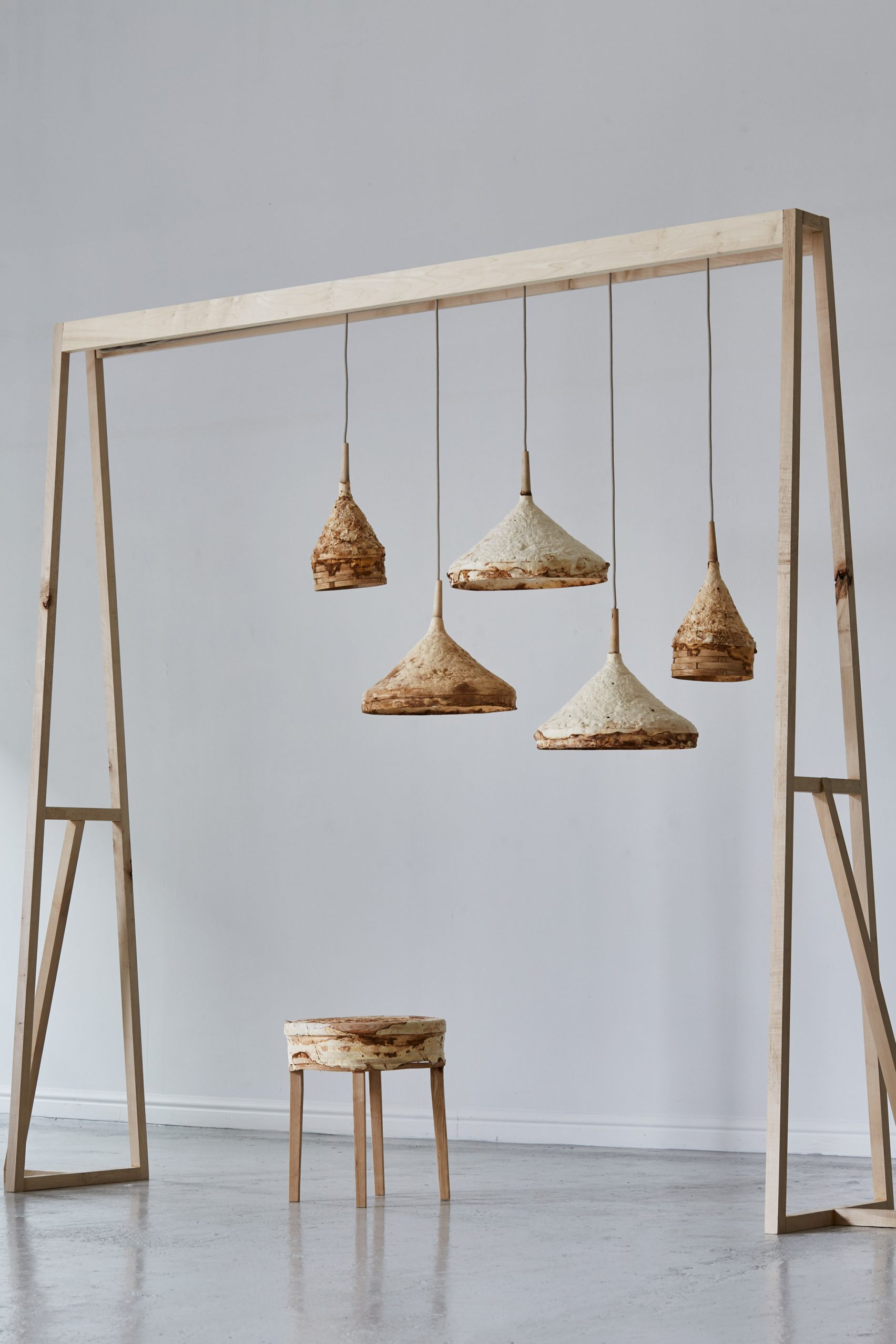
A haybox without hay!¶
 When I discovered than mycellium can be used as an insulating material and is easy to mould, I directly thing of a haybox. A haybox (also called: straw box, fireless cooker, insulation cooker, wonder oven, self-cooking apparatus, norwegian cooker or retained-heat cooker) is a cooker that utilizes the heat of the pot being cooked to complete the cooking process. Generally, it takes three times the normal cooking time to cook food in a haybox (more information on Wikipedia).
When I discovered than mycellium can be used as an insulating material and is easy to mould, I directly thing of a haybox. A haybox (also called: straw box, fireless cooker, insulation cooker, wonder oven, self-cooking apparatus, norwegian cooker or retained-heat cooker) is a cooker that utilizes the heat of the pot being cooked to complete the cooking process. Generally, it takes three times the normal cooking time to cook food in a haybox (more information on Wikipedia).
I thouhg than this method can help to get better result for dyeing buy keeping the dye bath hot longer with less energy.
Trying the mycelium¶
At Le textil Lab, Diane (local instructor) ordered a mycellium pack (21 L : 141.14€ with shipping) from Grown Bio.

Most of us make some small pieces and a lot was still available. With Amandine we make "the haybox without hay" using the upper part of an old coal stove as a mould.

Finishing¶
For the moment the mycellium is still growing.
To finish it, we will:
- cook it ;
- cut to make a cover part and a container part ;
- prepare a piece of wood to protect the mycellium material from the heat of the pan ;
- pprepare an other piece of wood for the outside bottom of the container part and fix it to protect it.
I really enjoyed to make this "hay box without hay", I think it's a precious low tech solution (I love low tech!).
3D clay print¶
At the end of november Amandine, Lauriane and I visited Nicolas David at his shop/workshop Tygre. He works with ceramics and porcelain in 3D printing in Lyon.
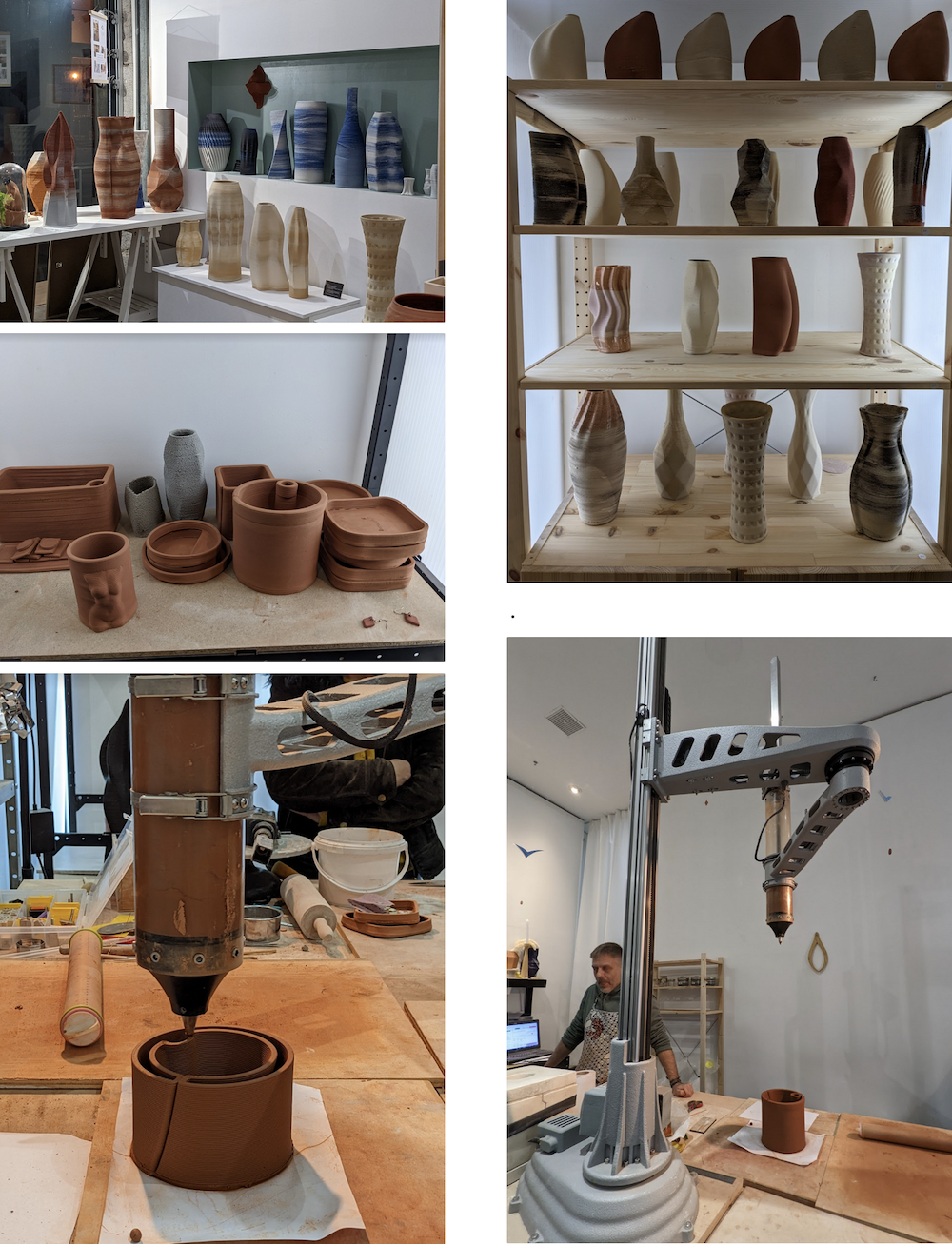 It was very inspiring to see how he plays with colors ans kind of clays or ceramics. He gave us the tip to get a 25% moisture to get a good consitancy for the clay print material.
It was very inspiring to see how he plays with colors ans kind of clays or ceramics. He gave us the tip to get a 25% moisture to get a good consitancy for the clay print material.
My week review for instagram¶
Recipes for the Textile Lab cookbook (fr)¶
Recipes: Alginate colored strings and Banana (almost) rubber